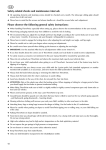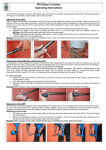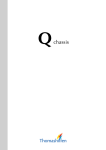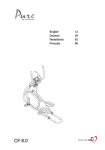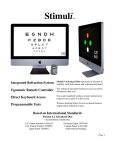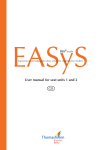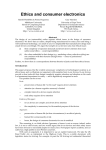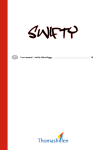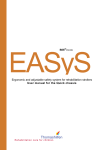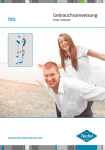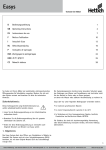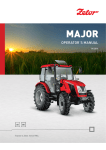Download Achassis
Transcript
A chassis . User manual for the A chassis.......................................................................12 A chassis + ThevoSeat A chassis + EASyS A chassis + EASyS Modular 3 4 (1) (2) (3) (4) (5a) (5b) (6) (7) (8) (10) (12) (9) (11) (13) 5 Contents 12 page Safety-related checks and maintenance intervals................................................................................................................ 13 General safety instructions................................................................................................................................................. 13 Purpose and use................................................................................................................................................................. 13 Risks and contraindications................................................................................................................................................ 13 Technical data.................................................................................................................................................................... 14 Setting up and assembly..................................................................................................................................................... 14 Folding............................................................................................................................................................................... 14 Front / rear facing function................................................................................................................................................. 15 Parking brake function........................................................................................................................................................ 15 Front wheel swivel lock...................................................................................................................................................... 15 Seat tilt-in-space adjustment............................................................................................................................................... 15 Tip assist............................................................................................................................................................................. 15 Suspension system.............................................................................................................................................................. 15 Transport............................................................................................................................................................................ 16 Basket................................................................................................................................................................................. 17 Product / serial number...................................................................................................................................................... 17 Cleaning, disinfecting, and care instructions....................................................................................................................... 17 Terms of guarantee / CE mark............................................................................................................................................. 17 Safety-related checks and maintenance intervals All operating elements and fastening screws should be subjected to visual inspection every month by a trained expert. Please observe the following safety instructions: Carefully read this user manual prior to first use. If lost, you can download the user manual in the download area of our website: www.thomashilfen.com. CAUTION: Wet or flat wheels may affect the brake. If not in use or stopping for a longer period, engage the stroller foot brake in order to prevent accidental rolling. CAUTION: The gap between chassis and release rod of the break may present a hazard if clothes and extremities get caught in the foot area. CAUTION: The gap between mounted seat (ThevoTwist / EASyS / EASyS Modular) and chassis frame may present a hazard for clothes and extremities getting caught in the seating area. CAUTION: Solar radiation, electronic heaters, or other heat sources may result in excessive heating-up of the seat / rehab stroller. On contact, this may cause a risk of burns at back and legs! Make sure that the seat / rehab stroller is not exposed to such heat sources at any time when in use or stored, and use it only when it has cooled sufficiently! Do not exceed the maximum size and weight capacity of the stroller. Please refer to the literature for specification details (s. technical data). We recommend that you always secure your child with the 2-point pelvic belt or another retention belt (available as an accessory). Never leave your child unattended in the stroller. Using reflective clothing increases visibility of yourself and your child to other road users, especially when strolling after dark. When lifting the stroller make sure to hold it at tightly welded or tightly screwed component parts only (frame tube above front wheels, rear axle, push bar). Be careful not to harm yourself when unfolding or folding the stroller. Attaching bags, equipment, or other heavy items may cause the stroller to be unstable and tip over. These items are best stowed in the basket below the seat unit. When working with the A chassis, please observe the recommendations in the user manual, especially when unfolding it and folding it together. Do not leave your child unattended when getting in or off the stroller. Excessive load of the footrest may lead to slipping off or tipping. Keep packaging material away from children- choking hazard! This stroller is intended to transport only one child. Hitherto existing market experiences do not result in any dangerous combinations of equipment with the seat. Purpose and use The chassis together with a suitable seating system is appropriate for ergonomic transfer (height adjustable push bar) of disabled children. Disabled children shall be transported at walking pace at the maximum on solid, even ground, indoors and outdoors. Transport shall be made by their parents or other qualified helpers. The chassis in combination with a seat unit (ThevoTwist / EASyS / EASyS Modular) must not be used for purposes other than intended (e.g. transporting more than one child, attaching shopping bags, etc.). Risks and contraindications Proper handling may avoid any use-related risks. No contraindications are known. 13 Technical data A chassis* Size 1 Size 2 Seat tilt-in-space -10° to +35° -10° to +35° Seat height 48 cm / 18.9" 54 cm / 21.3" Turning range of seat 180° 180° Safe static stability up to max. 10° 10° Push bar height 92 - 114 cm / 36.2 - 44.9" 92 - 120 cm / 36.2 - 47.2" Turning circle 83 cm / 32.7" 99 cm / 39" Wheel size (front (swivel wheels) / rear) 7,5" / 10" 7,5" / 10" Weight (w/o seat unit) 8,2 kg / 18.1 Ib 9,2 kg / 20.3 Ib Carrying capacity (incl. seat unit) 45 kg / 99.2 Ib 50 kg / 110.2 Ib Overall dimensions A chassis (l x w x h), in running order 75 x 60 x 77 cm / 29.5 x 23.6 x 30.3" 81 x 73 x 79 cm / 31.9 x 28.7 x 31.1" Folded dimensions A chassis (l x w x h) 83 x 64 x 41 cm / 32.7 x 25.2 x 16.1" 78 x 73 x 44 cm / 30.7 x 28.7 x 17.3" Overall dimensions (l x w x h), in running order with seat unit ThevoSeat 77 x 64 x 96 cm / 30.3 x 25.2 x 37.8" 81 x 73 x 99 cm / 31.9 x 28.7 x 39" Folded dimensions (l x w x h) with seat unit ThevoTwist 81 x 64 x 60 cm / 31.9 x 25.2 x 23.6" 88 x 73 x 64 cm / 34.6 x 28.7 x 25.2" Overall dimensions (l x w x h), in running order with seat unit EASyS 87 x 59 x 99 cm / 34.3 x 23.2 x 39" 80 x 73 x 99 cm / 31.5 x 28.7 x 39" Folded dimensions (l x w x h) with seat unit EASyS 81 x 59 x 49 cm / 31.9 x 23.2 x 19.3" 90 x 73 x 47 cm / 35.4 x 28.7 x 18.5" Overall dimensions (l x w x h), in running order with seat unit EASyS Modular 83 x 59 x 99 cm / 32.7 x 23.2 x 39" 83 x 64 x 99 cm / 32.7 x 25.2 x 39" Folded dimensions (l x w x h) with seat unit EASyS Modular 83 x 59 x 59 cm / 32.7 x 23.2 x 23.2" 99 x 64 x 75 cm / 39 x 25.2 x 29.5" * The A chassis is also available with fixed front wheels. Setting up and assembly Adjustments / adaptations shall be carried out by trained or instructed experts (e.g. medical device consultants of a medical device dealer) only. The seat can be removed from the A chassis without any tools. Push the click lever below the seat unit forwards and take the seat unit off the receiver adapter of the chassis forwards. Proceed in reverse order to insert the seat. (fig. 3) CAUTION: Always ensure the click lever engages audibly. Then make sure the seat has clicked into place by pulling it forwards. Commercially available tools are required for mounting / dismounting the accessories. Separate mounting instructions and user manuals are enclosed with the accessories. If they should be missing, you can download the instructions in the download area of our website www.thomashilfen.com Folding Unfolding Take hold of the rehabilitation strollers’ push bar and pull it upwards while supporting its base on the rear axle (pull it until you hear the push bar locking into place, fig. 1). If necessary, set the seat tilt horizontally (cf. seat tilt-in-space adjustment). Then bring the backrest to an upright position (release back clamping lever / gas spring release button). The foot rest is to be fixed to the knee joints. Place the grid joints one upon the other and connect them with the screws (from the inside), washers (from the outside), and wing nuts (from the outside). Folding together Bring the backrest to a lying position, loosen the knee angles, and swivel the foot rest over and down onto the seat unit. Move the seat tilt-in-space adjustment to a horizontal position (cf. seat tilt-in-space adjustment), then loosen the locking levers on both sides of the chassis (pull them up) and press the push bar down at the same time to fold it inwards into the frame. (fig. 2) CAUTION: Hold the chassis tight and do not let it fall. Do not apply the foot brake as the wheels may deform. Folding instructions: Make sure that the seat is in horizontal position when folding with the seat unit mounted. 14 Front / rear facing function SAFETY INFORMATION: Be sure to check correct and safe locking of the seat unit after each change is made and before a child is placed in a rehab stroller. Push the click lever under the seat unit forwards and remove the seat unit forwards from the chassis. Turn the seat unit around and insert it the other way around (snap it in place forwards, fig. 3). Parking brake function Remove the cable tie that fixes the brakes. Braking: Put your foot on the brake bar and press it down Unbraking: Put your foot under the brake bar and lift it up. CAUTION: The triggering pressure exceeds the norm to achieve a better braking effect. Front wheel swivel lock Swivel lock front wheels: Align the front wheel and fix the locking pin (it locks audibly). Swivel front wheels: Pull out the locking pin and fix it using a half-turn. (fig. 4) Seat tilt-in-space adjustment CAUTION: While adjusting the seat tilt-in-space, always hold the back of the stroller in place in order to avoid sudden changes in position of the child. We recommend adjusting the tilt without the child sitting in the seat. When adjusting the seat while the child is seated, the child must be secured by a second person. There are two possibilities to position the seat tilt-in-space of the A chassis: 1. Press the release clamp beneath the seat unit together and adjust the seat tilt-in-space as required, release the clamp. Check if the seat is locked. (fig. 5a) 2. For a comfortable adjustment of the seat tilt-in-space while standing, use the adjusting lever at the pushbar. Pull the lever to the tube and keep in place, adjust the required tilt and release the lever. Check if the seat is locked. (fig. 5b) CAUTION: Make sure the release lever is kept free at all times during everyday use and cannot be released / tightened accidentally (by pushing it / by contact with other objects), or else there will be an increased risk for the stroller to tip over or the child getting injured. Tip assist (Accessory) Place your foot on the tip assist, keep hold of the stroller with both hands and tip the stroller. (fig. 6) Suspension system Suspension activation Pull out the locking pin from the spring and fix it using a half-turn. (fig. 7) Suspension deactivation Fix the locking pin to the spring (it locks audibly). 15 Transporting the ThevoTwist, EASyS or EASyS Modular seat unit with A chassis The ThevoTwist, EASyS or EASyS Modular seat unit with A chassis can be folded for transport in the luggage area of a vehicle. The ThevoTwist, EASyS and EASyS Modular seat unit with A chassis has been successfully impact tested against international standard ISO 7176/19 and ANSI/RESNA WC/Vol.1 – Section 19 6/22/99 Draft and may be used as a vehicle seat. IMPORTANT: When used as a vehicle seat the following instructions must be followed. The ThevoTwist, EASyS or EASyS Modular seat unit with A chassis are designed to be forward-facing when used as a seat in a motor vehicle. The occupant should transfer to the vehicle seat and use the vehicle-installed restraint system whenever it is feasible! In order to fasten the A chassis at the floor of the vehicle, only use belt systems which meet the standard ISO 10542. The 4 tie-down securement points are indicated with the following symbol: CAUTION: When the stroller is being used as a seat in a motor vehicle the locking pin at the tilt-in-space mechanism must engage in a position that inclines the seat backwards. Preparing the EASyS, EASyS Modular or ThevoTwist seat unit with A chassis for transport: 1. Remove the following (if fitted); pommel, play tray, rain hood, sun canopy, grip rail, accessory bag and shopping basket contents. 2. Position the stroller correctly in the vehicle over the floor track with the front of the stroller facing towards the front of the vehicle (in the direction of travel). Put the brakes on. 3. Make sure the hip angle adjustment is locked. The locking pin at the backrest must be engaged (see marking). Securing the EASyS, EASyS Modular or ThevoTwist seat unit with A chassis in a Vehicle: 1. The stroller must be secured in a vehicle using a 4-point tie down system that complies with either ISO 10542 Part 2, SAE 2249 or DIN 75078/2. (Such restraints are manufactured by Unwin Safety Systems and Q’Straint) 2. Vehicle operators and/or assistants should be fully trained in the use of wheelchair tie-down and occupant restraint systems. 3. The two front tie-downs must be attached left and right side to the steel ring located on each front castor mounting boss (fig. 8). 4. The two rear tie-downs must be attached to the two securement points located on each side of the pushchair frame (fig. 9). Fitting the occupant restraint system: 1. The stroller passenger must be restrained using an approved vehicle safety belt. Thomashilfen recommends the use of either a split reel double inertia seat belt or a 3-point occupant restraint system. (Such restraints are manufactured by Unwin Safety Systems and Q’Straint) 2. Vehicle operators and/or assistants should be fully trained in the use of wheelchair tie-downs and occupant restraint systems. 3. The occupant lap belt must be routed low over the pelvis, avoiding contact with the abdomen of the passenger. Lap belt routing should be inside of the occupant side pad on both left and right sides of the pushchair (fig. 10). 4. The lap belt should not be held away from body by rehabilitation stroller components or parts, such as side pads or wheels (fig. 11). NOTE: The belt webbing should not be twisted when in use. 5. The angle of the pelvic belt should be within the optimal zone of 30° to 75° to the horizontal (fig. 12). 6. The occupant lap belt should be tightened to make a snug fit without causing discomfort to the passenger. 7. If the pushchair is fitted with a harness, this should only be fastened after the occupant restraint system. 8. The shoulder belt of the occupant restraint system must be fitted to the side wall of the vehicle at a height that ensures the seat belt webbing lays in the middle of the occupants shoulder. NOTE: To meet current regulations only a shoulder belt fitted to the side wall of the vehicle should be used to correctly restrain the occupant. 16 Basket Use snap hooks to attach the basket (with the gap at the back) to the four crescent-shaped rings. (fig. 13) When folding, the basket can remain mounted (maximum basket load: 5 kg / 11 lb). Product / serial number (conclusion on construction year) To make sure you receive correct spare parts or for potential technical recalls we always require the serial / batch number and exact item code. If you give us the serial / batch number, we can inform you about the construction year of your A chassis. You can find the serial / batch number of your A chassis on the barcode label, underneath the frame. Item-code Serial- / Batch number Cleaning, disinfecting, and care instructions The A chassis is manufactured from high-quality steel and aluminium tubing which is coated with a robust heat-enamel finish; and can be cleaned using commercially available non-toxic soap (neutral soap). Guarantee terms / CE marking Thomashilfen offers you a guarantee of 3 years for all frame parts, commencing on the date of purchase. This guarantee incorporates all claims which influence functionality. Damages due to improper use (e.g. overloading), and natural wear and tear are excluded. The A chassis meets the requirements of the European EN 12182 and 12183 standards and is provided with a CE marking. Enjoy using your rehabilitation stroller! 17 Z chassis . User manual for the Z chassis....................................................................... 8 Z chassis + ThevoSeat Z chassis + EASyS (1) (3) 2 (2) (4) (5) Safety-related checks and maintenance intervals All operating elements and fastening screws should be checked every month. The telescopic sliding plate should remain free of dirt and sand. Please bear in mind that the screws and release handles (hip angle adjustment) should be secured after each adjustment. Please observe the following general safety instructions: When handling Z chassis, especially when setting up, please observe the recommendations in the user manual. Please keep packaging material away from children to avoid the risk of choking. We recommend that you adjust the seat depth and lower leg length according to the current body size of your child at least every 3 months. If necessary, ask your therapist / orthopaedist for assistance. Please bear in mind to engage the locking device after adjusting the seat height, seat angle, and hip angle. Please be careful not to catch your fingers when carrying out adjustments. Be careful not to harm yourself when folding up the footrest or adjusting the seat height. IMPORTANT: Use the attached Allen key for all adjustments (Allen screw 3mm/0.1"). If you have doubts about the correct use of Z chassis consult your local dealer to avoid incorrect adjustments. For safety reasons accessories not mentioned in this user manual should be mounted by specialists only. Please do not overload your Z chassis and observe the maximum load capacity (see technical data). Only one child should be seated in Z chassis. Do not leave your child unattended when getting in or off Z chassis. Excessive load of the footrest may lead to slipping off or tipping. We recommend that you always secure your child with the 2-point pelvic belt or another retention belt (available as an accessory), and never leave the child unattended in Z chassis. Always lock the brake before placing or removing the child from Z chassis. Always lock the brake when the chair is stationary to avoid rolling. Avoid any obstacles in the way of the chair, do not push the chair into them. ATTENTION: Wet wheels may affect the braking action. When stopping or halting for a longer period of time you should apply the foot brake to prevent inadvertent rolling. The Z chassis is supplied with the seat adapter mounted facing forwards. Never pull it out completely and replace it facing the opposite way. RISK OF TIPPING OVER! Stop your child from leaning out to the front or side. RISK OF TIPPING OVER! When lifting Z chassis make sure to hold it at tightly welded or tightly screwed component parts only (frame tube at front and rear wheels). Please avoid uneven ground, as this may cause Z chassis to tip over. Ground beams should be passed over only when the base frame is tilted to stand on the rear wheels (going upwards – pull backwards, going downwards – lowering slowly). Stairs must only be taken with the aid of an accompanying person. If available, elevators or similar equipment should be used. If such equipment is unavailable, the obstacle should be passed with the chair being carried by two persons, without the child sitting in it. Please be careful when pushing on slopes to avoid Z chassis tipping over or rolling away, or your child falling out of the chair. Parking Z chassis on slopes should be avoided. From time to time you should wipe off the dirt from the wheels. Use a damp cloth and make sure you dry thoroughly. Do not use strong solvent. High solar radiation may lead to high surface temperature on the dark upholstery material. Do not expose the gas springs to high pressure or temperatures. Do not loosen or remove any screws unless otherwise stated. Keep Z chassis away from naked flames. 9 Purpose and use The chassis is, in association with a compatible / convenient seat-system for egonomic transfer of disabled children, suitable for indoor use. Risks and contraindications Proper handling may avoid any use-related risks. No contraindications are known. Technical data Seat tilt-in-space Seat height with seat unit Total dimensions (l x w x h) Size of swivel wheels (front) Size of swivel wheels (rear with brake) Weight (without seat unit) Carrying capacity -15° to +35° 39 - 58.5 cm / 15.4 – 23" 65 x 54 x 33 - 51 cm 25.6 x 21.3 x 13 - 20.1" 3" 3" 7.2 kg / 15.9 lb 40 kg / 88.1 lb Installing the seat unit size 1 When installing the seat unit, make sure that the longer section of the chassis arm is at the back (fig. 1). The seat unit must be positioned centrally between the spacers. (fig. 2) Installing the seat unit size 2 Before installing the seat unit 2 on the Z chassis, the four spacers on the seat adapter must be removed. (fig. 2) Seat height adjustment CAUTION: Only adjust the seat height when the child is not in the seat. Adjusting with the child in the seat may cause the seat unit to tip unexpectedly with a risk of injury to the child. Hold onto the seat unit firmly with one hand. Loosen the levers on each side. Now adjust the seat to the desired height and re-tighten the screws. (fig. 3) CAUTION: Do not pull out the telescoping tube past the markings. Seat tilt adjustment Release the clamping lever beneath the centre of the seat unit, pull out the locking pin on the right of the seat adapter and adjust the seat to the desired angle. Then re-tighten the clamping lever. (fig. 4-5) CAUTION: When adjusting the seat tilt, hold on to the back of the seat firmly in order to avoid sudden changes to the child‘s position. We recommend that you make these adjustments when the child is not in the seat. Brake function The rear castors are equipped with easily accessible and easy to use brakes. The brakes prevent the wheels both from turning and from swivelling, so that the Z chassis can be safely parked via the rear wheels alone. 10 Cleaning, disinfecting and care instructions The Z chassis is manufactured from high-quality steel and aluminium tubing which is coated with a robust heat-enamel finish; and can be cleaned using commercially available no-toxic soap (neutral soap). Terms of guarantee / CE mark Thomashilfen offers you a guarantee of 3 years for all frame parts, commencing on the date of purchase. This guarantee incorporates all claims which influence functionality. Damages due to improper use (e.g. overloading), and natural wear and tear are excluded. Z chassis meets the requirements of the European standards EN 12182 and 12183 and is provided with a CE marking. Enjoy your Z chassis! 11 Q chassis . User manual for the Q chassis......................................................................8 Q chassis + ThevoSeat Q chassis + EASyS Q chassis + tRide (1) (2) (3) (5) (6) (4a) (4b) Page 8 Safety-related checks and maintenance intervals............................................................................................... 9 General safety instructions................................................................................................................................ 9 Purpose and use............................................................................................................................................... 10 Risks and contraindications............................................................................................................................... 10 Technical data.................................................................................................................................................. 10 Setting up and assembly................................................................................................................................... 10 Installing the seat unit....................................................................................................................................... 10 Folding............................................................................................................................................................. 10 Seat height adjustment...................................................................................................................................... 10 Seat tilt-in-space adjustment.............................................................................................................................. 11 Parking brake function...................................................................................................................................... 11 Cleaning, disinfecting, and care instructions..................................................................................................... 11 Terms of guarantee / CE mark........................................................................................................................... 11 Safety-related checks and maintenance intervals All operating elements and fastening screws should be checked every month. The telescopic sliding plate should remain free of dirt and sand. Please bear in mind that the screws and release handles (hip angle adjustment) should be secured after each adjustment. Please observe the following general safety instructions: When handling Q chassis, especially when setting up, please observe the recommendations in the user manual. Please keep packaging material away from children to avoid the risk of choking. We recommend that you adjust the seat depth and lower leg length according to the current body size of your child at least every 3 months. If necessary, ask your therapist / orthopaedist for assistance. Please bear in mind to engage the locking device after adjusting the seat height, seat angle, and hip angle. Please be careful not to catch your fingers when carrying out adjustments. Be careful not to harm yourself when folding up the footrest or adjusting the seat height. IMPORTANT: Use the attached Allen key for all adjustments (Allen screw 3mm/0.1”). If you have doubts about the correct use of Q chassis consult your local dealer to avoid incorrect adjustments. For safety reasons accessories not mentioned in this user manual should be mounted by specialists only. Please do not overload your Q chassis and observe the maximum load capacity (see technical data). Only one child should be seated in Q chassis. Do not leave your child unattended when getting in or off Q chassis. Excessive load of the footrest may lead to slipping off or tipping. We recommend that you always secure your child with the 2-point pelvic belt (standard equipment) or another retention belt (available as an accessory), and never leave the child unattended in Q chassis. Always lock the brake before placing or removing the child from Q chassis. Always lock the brake when the chair is stationary to avoid rolling. Avoid any obstacles in the way of the chair, do not push the chair into them. ATTENTION: Wet wheels may affect the braking action. When stopping or halting for a longer period of time you should apply the foot brake to prevent inadvertent rolling. When lifting Q chassis make sure to hold it at tightly welded or tightly screwed component parts only (frame tube at front and rear wheels). Please avoid uneven ground, as this may cause Q chassis to tip over. Ground beams should be passed over only when the base frame is tilted to stand on the rear wheels (going upwards – pull backwards, going downwards – lowering slowly). Stairs must only be taken with the aid of an accompanying person. If available, elevators or similar equipment should be used. If such equipment is unavailable, the obstacle should be passed with the chair being carried by two persons, without the child sitting in it. Please be careful when pushing on slopes to avoid Q chassis tipping over or rolling away, or your child falling out of the chair. Parking Q chassis on slopes should be avoided. From time to time you should wipe off the dirt from the wheels. Use a damp cloth and make sure you dry thoroughly. Do not use strong solvent. High solar radiation may lead to high surface temperature on the dark upholstery material. Do not expose the gas springs to high pressure or temperatures. Do not loosen or remove any screws unless otherwise stated. Keep Q chassis away from naked flames. 9 Purpose and use The chassis is, in association with a compatible / convenient seat-system for egonomic transfer of disabled children, suitable for indoor use. Risks and contraindications Proper handling may avoid any use-related risks. No contraindications are known. Technical data Seat tilt-in-space Seat height with seat unit Total dimensions (l x w x h) Adapter height Size of swivel wheels (front) Size of swivel wheels (rear with brake) Weight (without seat unit) Carrying capacity -7 to +31° 29 - 69 cm / 11.4 – 27.2" 76 x 54 x 25 - 62 cm / 29.9 x 21.3 x 9.8 - 24.4" 21 - 60 cm / 8.3 – 23.6" 100 mm / 3.9" 100 mm / 3.9" 13.5 kg / 29.8 lb 50 kg / 110.2 lb Setting up and assembly The base frame is supplied already fully mounted and folded together. Loosen the locking pin at the foot pedal and lock it by doing a quarter turn. You can now adjust the seat height and, if necessary, the seat tilt-in-space. (fig. 1-3) Installing the seat unit size 1 The seat unit must be positioned centrally between the spacers. (Fig. 4a) Installing the seat unit size 2 Before installing seat unit size 2 on the Q chassis, the four spacers on the seat adapter must be moved into the outer holes. (Fig. 4b) Folding Bring the backrest to the maximum horizontal position, loosen the knee angles and swivel the footrest over and down onto the seat unit (fig. 5). Move the seat tilt adjustment to a horizontal position and lower the seat unit down to the ground (see seat height adjustment). CAUTION: Hold the frame with one hand when folding to avoid it tipping over. Be careful not to catch your fingers. Seat height adjustment The seat unit can be lowered down to the ground. Apply the right foot pedal at the back of the base frame (fig. 1-3). Now push the seat unit down (at the back, the armrests or the push bar, if available) or pull it upwards until the desired height is reached. To keep the height, simply remove your foot from the pedal. The seat height can also be adjusted during use of the chair. It may then be necessary for two people to lift the seat to the desired height. For safety reasons the seat height adjustment can be locked. The adjustment is locked when the locking pin to the left of the pedal is engaged (fig. 2). To unlock, pull out the locking pin and do a quarter turn. 10 Seat tilt-in-space adjustment To adjust the seat tilt-in-space, use the pedal on the left side of the rear frame (fig. 2-3). First, engage the brakes. Now either push the seat unit forwards (at the back, the armrests or the push bar, if available) or pull it backwards until the desired angle is reached. To keep the angle, remove your foot from the pedal. The seat tilt-in-space can also be adjusted during use of the chair. It may then be necessary for two people to adjust the desired seat angle. For safety reasons the seat tilt-in-space adjustment can be locked. The adjustment is locked when the locking pin to the left of the pedal is engaged (fig. 2). To unlock, pull out the locking pin and do a quarter turn. IMPORTANT: The seat height adjustment and seat tilt-in-space adjustment should always be locked during use of the chair. CAUTION: When adjusting the seat height or seat tilt-in-space one person must secure the seating systems with both hands to avoid sudden changes of the child’s position. We recommend carrying out this setting without the child in the seat unit. Parking brake function Locking / releasing the castors The rear castors are equipped with easily accessible and easy to use brakes. To lock the castors press the locking device down. By pushing the locking device up again the castors become flexible. The brakes prevent the castors both from turning and from swivelling, so that the base frame can be safely parked via the rear wheels alone (fig. 6). Cleaning, disinfecting and care instructions The Q chassis is manufactured from high-quality steel and aluminium tubing which is coated with a robust heat-enamel finish; and can be cleaned using commercially available no-toxic soap (neutral soap). Terms of guarantee / CE mark Thomashilfen offers you a guarantee of 3 years for all frame parts, commencing on the date of purchase. This guarantee incorporates all claims which influence functionality. Damages due to improper use (e.g. overloading), and natural wear and tear are excluded. Q chassis meets the requirements of the European standards EN 12182 and 12183 and is provided with a CE marking. Enjoy your Q chassis! 11





















